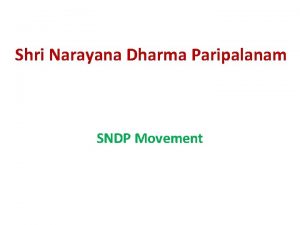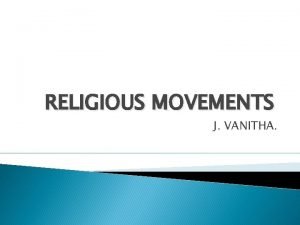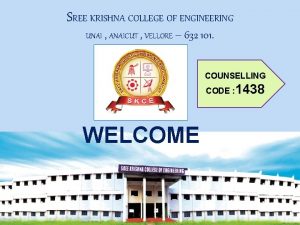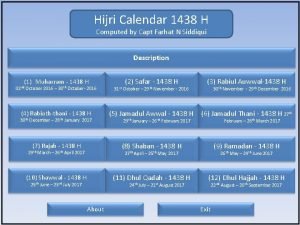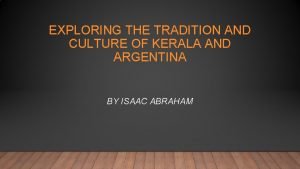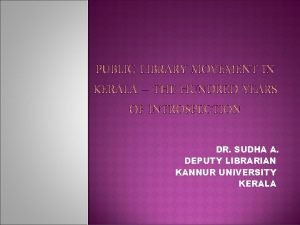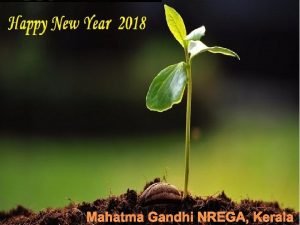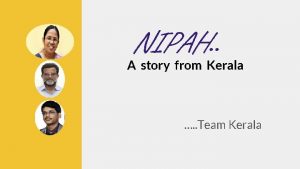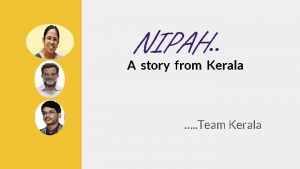RELIGIOUS MOVEMENTS J VANITHA SNDP MOVEMENT KERALA Sree















- Slides: 15

RELIGIOUS MOVEMENTS J. VANITHA.

SNDP MOVEMENT - KERALA Sree Narayana Movement - From 1880 s Empower Through Organization, Enlighten Through Education One Caste, One Religion, One God for Mankind

Sree Narayana Guru Dharma Paripalana Yogam – 1903. � Casteless organization open to all people. � Started in 1903. � Aims at the economic, political and educational improvement of the Ezhava community. � Sri Narayana Guru was chosen as the life president. � He joined hands with Dr. Palpu. � 1928 he died, his samadhi became a pilgrimage centre.

Kerala

SNDP MOVEMENT - KERALA � Two important programmes of SNDP. � Encouraging education by starting educational institutions. � Building temples and simplifying rituals.

EDUCATIONAL REFORMS � First step is to uplift the Ezhava Community – the depressed group of Kerala. � Narayana Guru (Asan) started number of schools and colleges through out Kerala to spread education on a massive scale among the community.

RELIGIOUS REFORMS � Sri Narayana Guru built a number of temples, simplified the rituals regarding the worship, marriage and funeral. � He wanted to help the people of his community in secular and also spiritual matters. � He travelled 15 years through out Kerala and helped the community people to develop self -confidence, social awareness and scene of cleanliness. (houses, streets, food habits etc)

RELIGIOUS REFORMS cont… � Narayana Guru was born as Hindu and died as Hindu. He was not against religion but struggled to correct some irregularities involved in Hindu society. � Avarnas Vs Brahmins. � He consecrated Shiva temple at Aruvipuram in 1888. After this he consecrated more than 60 temples indifferent parts of South India. � This proved to be a means of emancipation for millions of people who were denied admission to the temples.

RELIGIOUS REFORMS cont… � Sri Narayana Guru introduced three specific religious reforms along with consecration of new temples. � Firstly, he consecrated higher Gods in the place of lower Gods and appointed dedicated sanyasis from his own community as priests. � Secondly, he suggested his followers to build new temples in a simple and less expensive way.

RELIGIOUS REFORMS cont… � Thirdly, he introduced notable change in his task of founding new temples. He never made idol worship compulsory to his followers. � eg: He consecrated “Sivalikha”, a huge brass oil lamp instead of an idol (Kammukha Kshetham in Thrissur in 1920 with saying “Let there be light”. � In another temple at Murukkunpuzha he consecrated a plain stone with inscription “Truth, Charity, Love and Mercy”.

RELIGIOUS REFORMS cont… Establishment of 3 types of temple 1. There are temples with poojas or regular worship and festivals. 2. There are temples with idols and no customary poojas or celebration. 3. There are temples with no idols or images. It is obvious that he consecrated different types of temples to cater to the different types of emotional and spiritual needs of the people.

SOCIAL REFORMS OF SNDP YOGAM Emphasis of Education and Sanskritisation � By making use of 2 means modern education and Sanskritisation Sri Narayana Guru was able to transform the Ezhavas from untouchable group in Kerala to a background caste community within a short period of 30 years. � He started temple entry programmes in association with Nair Service Society (NSS)

SOCIAL REFORMS OF SNDP YOGAM � He appealed to his community people to stop the expensive customs such as “mock marriage” (Thalikattu Sampradhayam), puberty festival for girls (Thirukkuli) and a festival associated with pregnancy after marriage called Puaikuli. � He opposed the practice of drinking alcohol. � The essence of his work is Jati Mimasa (A critique of caste).

OPPOSITION TO THE PRACTISE OF UNTOUCHABILITY � Opposed the practice of untouchability. � He practiced caste equality and suggested his followers not to ask another’s caste. � He criticized Government procedure of seeking caste identification in official documents. � He criticized Gandhiji’s faith in “Chaturvana System” � He mingled and lived with down trodden masses. � He appointed a cook of low caste origin in his mutt at Shivagiri.

SNDP YOGAM TODAY � Powerful organization of Ezhava Community. � Publishes articles, booklets, books etc. (in the view of Narayana Guru). � Non-political organization through out Asan’s life. � After his death drawn into politics (middle class supported Congress Party, lower class supported Communist Party)
 Sndp movement upsc
Sndp movement upsc Sndp movement in india
Sndp movement in india Sree krishna college of engineering vellore
Sree krishna college of engineering vellore Teachings of sree narayana guru
Teachings of sree narayana guru Locomotor dance movements
Locomotor dance movements Homenext.vodafone/vam/portal
Homenext.vodafone/vam/portal Mega projects in kerala
Mega projects in kerala Land of letters in kerala
Land of letters in kerala Pradhan mantri krishi sinchayee yojana in kerala
Pradhan mantri krishi sinchayee yojana in kerala Kerala 2017
Kerala 2017 Hijri committee calendar
Hijri committee calendar Culture and tradition of kerala
Culture and tradition of kerala Dwms kerala
Dwms kerala Medisep hospitals in kerala
Medisep hospitals in kerala Slna kerala
Slna kerala State library trivandrum
State library trivandrum
